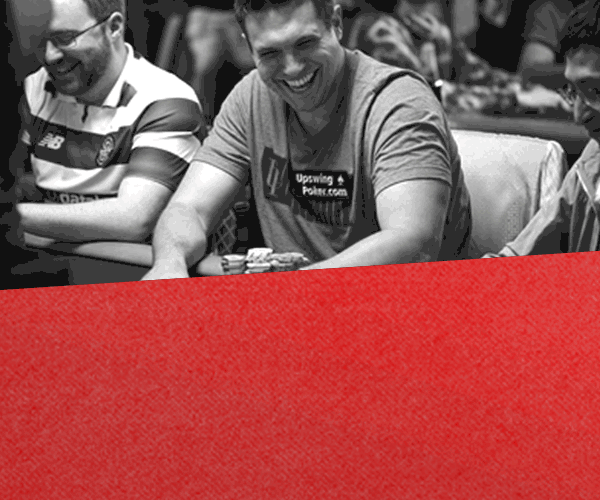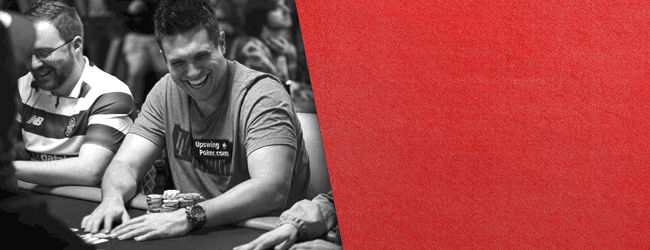Why The Very Best Poker Players Make Decisions At Random (Mixed Strategy)
The many randomized elements of poker are a big part of what makes the game so strategically complex.
We can never know with 100% certainty what cards our opponents have, nor what cards are going to be dealt on the flop, turn and river. So why on earth would anyone want to add more randomized elements to the game?
Believe it or not, the best poker players in the world make some decisions at random–almost like rolling dice to see how many squares you get to move in Monopoly.
Before going into how–and why–they do it, I need to explain frequency-based decision-making.
Optimal frequencies (usually) require a mixed strategy
When constructing an ‘optimal’ poker strategy, we strive to make each decision at a certain frequency (e.g. you must call with at least 33% of the hands in your range when you’re getting 2-to-1 pot odds).
In certain scenarios, it is optimal to choose different actions with the exact same hand at differing frequencies.
Why would we want to do this?
Imagine that you are playing against two opponents, Player A and Player B, in a three-handed cash game.
Player A always makes the same decision with all combinations of a specific hand. By contrast, Player B uses a ‘mixed strategy’, where she will sometimes mix up her decisions with different combinations of the same hand at certain frequencies.
Players that employ an effective mixed strategy are tough to beat because we can’t make as many definitive assumptions about their ranges.
For instance, you open from the button and Player A is in the big blind with A♠Q♦. AQo is far strong enough to 3-bet for value against a button open, so Player A will always 3-bet it.
Player B would approach the spot differently. She will still try to extract value with AQo a large majority of the time–say 85%–but will also call the raise at some frequency–the remaining 15%.
We can completely eliminate AQo from Player A‘s range whenever he calls our open. This information allows us to put more pressure on him when the flop is something like A-Q-2 or K-J-T. Player B‘s mixed strategy helps protect her range on such boards.
(Note: Learn and master the methods behind world class poker players’ successes in The Lab, an extensive poker training course that is updated every month. Click here or below to learn more!)

With frequency-based decision-making covered, let’s get onto the randomization talk.
We as humans have biases that make us unable to accurately execute frequency-based decisions as intended. You can “randomly” think of a number from 1 to 5, but your choice won’t be truly random. It will be based on a countless number of unconscious psychological variables.
If you want to 3-bet your AQo combos from the big blind 85% of the time, you will need to use a tool or technique in order to ensure accuracy.
This is where random number generators–or RNGs–and other makeshift randomization techniques come into play.
Using a random number generator
A simple way to accurately execute frequency-based decisions is by using a random number generator. If you type ‘rng’ into Google, there’s actually an embedded one that comes up in the search which is really fast to use:
Just set the range to be between 1 and 100, and use the output to determine which action you should make depending upon your pre-determined frequencies.
For instance, say you want to 3-bet your AJo combos 33% of the time and call 67% in a certain scenario. You can execute your mixed strategy accurately if you 3-bet when the number is between 1 and 33, and call when the number is between 34 to 100.
If you’re after an embedded RNG inside your poker client, there’s software available such as StarsHelper (https://starshelper.net/) where this is possible.
Upswing coach and GTO boss Fried Meulders makes use of an embedded RNG like this to help implement a balanced mixed strategy:
Fried uses a built-in RNG (circled) on PokerStars
What if I can’t access a random number generator?
If you can’t use an RNG – like when playing live – you can use a makeshift randomization technique, which is far better than trying to estimate yourself.
The easiest one requires a clock, ideally on your wrist or the wall so you don’t have to look at your phone.
Let’s say you decide you want to call 50% of the time and fold 50% of the time in a spot. You can call when the minutes number is even and fold when it’s odd.
For smaller frequencies–like 33%/67%–you can split your clock into thirds, with :00-:19 meaning one action and :20-:59 meaning the other.
(The seconds hand on an analog watch or clock is ideal for this.)
When should I use a mixed strategy?
The advantage of using a mixed strategy is that it helps keep you balanced and difficult to exploit, but this is not always necessary. Sometimes it is better to deviate from frequency-based decision-making.
For example, from a theoretical standpoint it might be optimal to flat a late position open with AA at some frequency (let’s say 3% of the time). If you are at a 9-handed live game with a ton of limping and calling, however, it will be more profitable to go for value with a 3-bet 100% of the time.
A player who misses value with AA because the clock read between 2:00 and 2:02 is being penny wise and pound foolish.
That said, splitting your combos based upon frequencies is worth mixing in when you’re up against strong opponents.
Here are some examples of situations where you can justifiably get the RNG out:
- Marginal open-raising spots
When you have a close decision regarding whether or not you should open-raise a certain hand pre-flop, using an RNG is a good way to make sure that you don’t lean too much in one direction.
There was a good example of this in one of Fried’s Play & Explain videos in The Upswing Lab. (If you’re a member and want to hear Fried’s explanation for yourself, it’s at 41:25 of the June 16th video here.)
Playing 6-max at the 500NL Zoom tables on PokerStars, his UTG RFI range includes opening 76s at 50% frequency, meaning that he’ll open-raise this hand when the RNG reads between 51 and 100.
- 3-bet spots
You’ll often run into pre-flop situations where both 3-betting or calling is profitable with your specific hand.
However, if you find yourself always 3-betting or always calling in such spots, your frequencies may get thrown out of whack. Check out the following BB vs CO RFI range from The Upswing Lab, for example:
BB continue range vs CO RFI recommended by The Upswing Lab
You’ll notice that hands like AJo and KQo fall into the 3-bet or call category. There are 12 possible combos for each off-suit hand, so it would be easy to accidentally 3-bet too often if you decide to 3-bet vs a CO open with every combo of AJo and KQo.
Deciding on frequencies based upon the bet sizing you face/the sizing you use is a good way to prevent over-3-betting. Once you’ve decided on your frequencies, you can use the RNG or your own makeshift method to keep these in check and prevent your 3-bet stats from getting too out of line.
- Bluffing spots
There will be times where you might want to take an aggressive bluffing line with certain hands a fraction of the time.
Let’s say we have 5♠5♦ on 9♠3♣2♦4♥K♥ and are considering a raise versus a river bet as a bluff with our blockers to the nuts.
Assume our range contains 7 combos of value hands given the action (hypothetically 3 combos of 9-9 and 4 combos of 65s). We want to have a value to bluff ratio of around 2:1.
If we were to raise all 6 combos of 5-5 here, our value to bluff ratio would be 3.5:3 and we will find ourselves over-bluffing from a theoretical standpoint.
In comes the RNG. If we decide to raise when we have 5-5 only 50% of the time–folding the rest–we can balance our value to bluff ratio to a less exploitable 3.5:1.5.
I hope this article helped you understand why randomization techniques can be useful when implementing an optimal and balanced strategy.
Let me know in the comments below if you’ve got any other randomization techniques that you use instead of a RNG. We need to help out the minority of non-clock owners here!
(Note: If you’re serious about improving your cash game and tournament skills, check out The Upswing Lab. Click here to learn more about this poker training course developed by Doug Polk & Ryan Fee.)

Read more from George and Upswing Poker:
- Gain a better understanding of frequency-based decision-making in How Top Pros Analyze Poker Hands in 2017
- Boost your win-rate in preflop multiway pots with The Ultimate Guide to Preflop Multiway Pots
- Learn how to select hands pre-flop with double the cards in PLO Starting Hands: 3 Things You Must Consider
- Go back to the top of this article about RNGs and mixed strategies